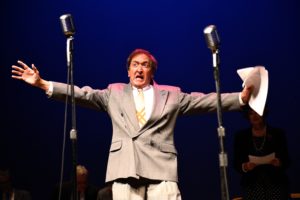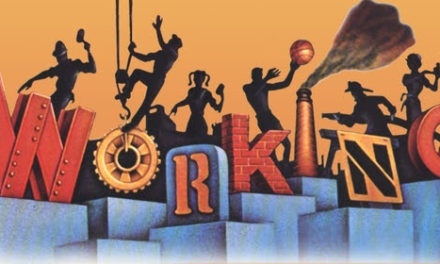(Above: Radio Redux, founded and directed by Fred Crafts, recreates mid-20th century radio shows, with the audience taking the role of studio audiences of the 1940s and ’50s)
By Randi Bjornstad
Episodes from two of the most popular serial comedies in radio history — the “Fibber McGee and Molly Show” and “Pat Novak, for Hire” — will be recreated onstage by Fred Crafts’ Radio Redux ensemble for three performances on Nov. 3, 4 and 5.
“The ‘Fibber McGee and Molly Show’ charms with its old-fashioned homespun humor, while ‘Pat Novak, for Hire’ brings laughs through its cleverly tortured similes,” Crafts wrote enthusiastically in his announcement of the production. “These shows are true radio classics. They don’t get better than this.”
The Fibber McGee and Molly episode that Radio Redux will offer is titled “Cleaning Out the Hall Closet.” It originally aired in 1940 and introduced one of radio’s most beloved and recognizable sound effects, a seemingly endless — and unendingly noisy — deluge of household objects let loose with the opening of the hall closet door in the McGee household, where Fibber stored all manner of detritus, “organized just the way I want it.”
The show also inadvertently gave rise to several quips that became part of the 1940s lexicon, including Molly’s wifely remonstrance, “T’aint funny, McGee.”

Actor Sandy Silverthorne is Fibber McGee in Radio Redux’s production of “Fibber McGee and Molly” (Photo by Scott Kelley)
The real-life husband-and-wife team of Jim and Marian Jordan, who played the radio couple Fibber and Molly McGee, had starred in a previous radio show called “Smackout.” The gist of “Fibber McGee and Molly” was the day-to-day life of a working class couple and their friends and neighbors in a mythical town called Wistful Vista.
Fibber was an inveterate tall-tale teller, while Molly was a woman of few, but pithy, words who had his number but loved him nonetheless. Plot lines centered on the privations of the Great Depression and its effect on the McGees and their neighbors in what amounted to what today would be termed a sitcom. A later TV version of the show, cast with different actors, was not a great success.
After intermission, Radio Redux’s attention turns to “Rory Malone,” an episode of the “Pat Novak, for Hire” franchise, which Crafts describes as “a delicious sendup of colorful pulp dialogue.”
“A line like ‘She sauntered in, moving slowly from side to side like 118 pounds of warm smoke’ is irresistible,” he said.
The show originated in San Francisco and aired in 1946 and 1947 on the West Coast before being picked up nationally by the American Broadcasting Network in 1949.

Ken Hof plays the title role in Radio Redux’s production of “Pat Novak, For Hire” (Photo by Scott Kelley)
Each episode opened to the sound of a foghorn and Pat Novak — who’s really not a private eye at all but the owner of a boat shop on a San Francisco pier who seems to attract trouble — giving his name, followed by “for hire.” Novak and his sidekick, Jocko, usually find themselves in hot water after accepting a dangerous job that inevitably runs afoul of the local police inspector.
This segment of the show is a “crime noir” plot in which a fight manager hires the wisecracking detective to ferret out why some shady gangster types seem to be after his not-so-good boxer. Jack Webb, later of the “Dragnet” radio and TV show, wrote the original scripts with his roommate, Richard Breen, and he first played the Pat Novak character.
Sandy Silverthorne and Rebecca Nachison lead the Radio Redux cast in “Fibber McGee and Molly,” with Ken Hof, Scott Barkhurst and Don Aday taking the lead in “Pat Novak, for Hire.”
Other performers in the two episdoes are Achilles Massahos, Judi Weinkauf, Al Villanueva, Steve Wehmeier, with Radio Redux founder and director Crafts also taking a part.
Radio Redux
When: 7:30 p.m. on Friday and Saturday, Nov. 3-4, and 2 p.m. on Sunday, Nov. 5
Where: Soreng Theater, Hult Center for the Performing Arts, One Eugene Center at Seventh and Willamette streets in downtown Eugene
Details: “Explore,” a free behind-the-show talk by radio and film historian Patrick Lucanio, begins 45 minutes before each showtime in The Studio on the lower level of the Hult Center; an exhibition of radio-related collectibles and historic memorabilia is on display, courtesy of Bob Hart of the Lane County History Museum and Dennis Wright of the Radio Days Theater of the Mind Museum in Sutherlin; the cast mingles with the audience in the Hult Center lobby after the show
Tickets: $22 adults, $19 for senior citizens, $15 for students and $16 each for groups of five or more, available at the Hult Center box office, 541-682-5000, or online at hultcenter.org/









